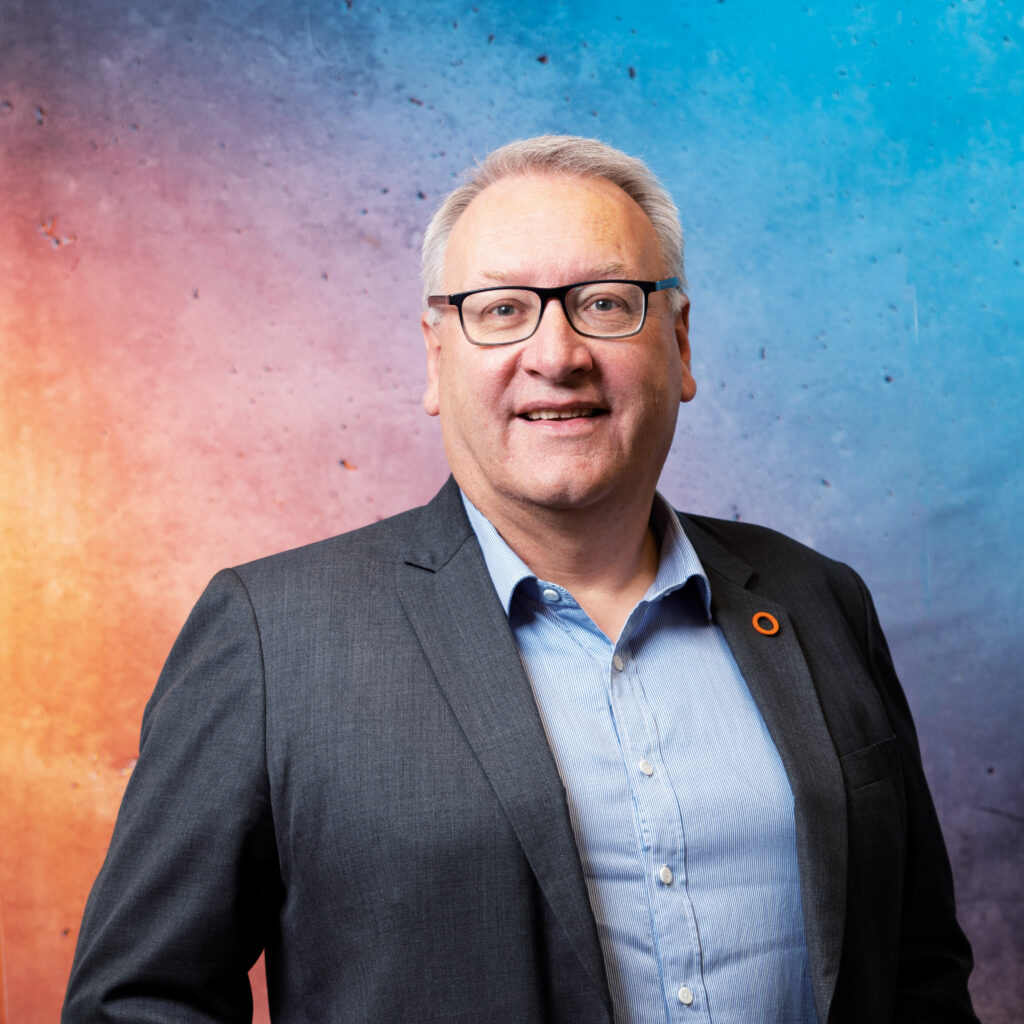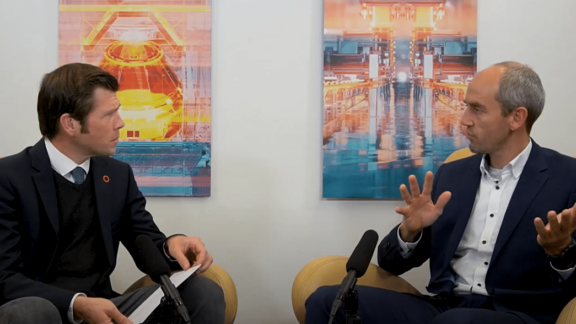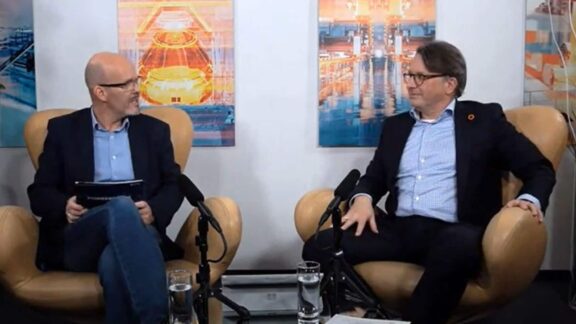From the automotive industry to engineering or electronics, steel producers need to supply a diverse range of companies. As a manufacturer of steel plants, it is crucial for Primetals Technologies to not only understand our direct customers but also these customers of our customers. In the sixth episode of Pioneers Talk, our guest Peter Oertelt, Head of Integrated Plants, addresses the issues and developments that accompany this focus and which developments in the steel industry he has identified as the most important ones.

Interview with
Peter Örtelt
Hello and welcome to Pioneers Talk. My name is Tom Widter and today I am going to discuss with Peter Örtelt a variety of topics around the theme of strategizing the future of metals production. The reason I have invited Peter Örtelt is that he is heading the Integrated Plants team at Primetals Technologies. They handle everything from business model consultation through finding and improving production routes to looking at the nitty-gritty that comes to the fore when you scratch at the surface of any production route. Peter, one of the reasons why I enjoy our conversations so much is that you unite two areas. One is having a broad scope of all the technologies that we as a company provide, which is unarguable quite a lot, and on the other hand you’re a strategic thinker. Both qualities make your work fascinating but also daunting to someone from the marketing department. I was wondering if you could tell us a little bit about your observations, though not regarding our customers which are the steel producers, but about the customers of our customers. Are there any trends that you’ve observed that many customers of these steel producers have established?
Örtelt: For sure, one of the trends is a kind of consolidation. So, if you look for instance at the automotive industry, some years ago OEMs were acting as single brands. Let us take the example of Fiat, Chrysler, Opel and Peugeot, now they’re acting as Stellantis group. So, they are having more market power and this is for sure one thing that can be seen as a trend. If you look at the whole production chain from raw materials down to the final products for instance, also on the raw material side you can see a consolidation of big players. Now this trend I would say is swapping over to the steel industry. Especially if you look at China, there is a consolidation ongoing towards big players and in China nearly 50 % of the steel production is done and so this is a big thing.
A big thing in a big country with even bigger players in the future, that’s interesting.
Örtelt: And another trend comes from the society. There is more and more pressure towards, I would call it “green products”. You can see that there is pressure that the end product is produced with lowest CO2 levels, lowest energy consumption or lowest other emissions. Not only running the car within lowest emissions standards but also during the production chain. This is one of the topics and there is a certain pressure down to the steel industry to fulfill these requirements.
Okay, I guess it’s clear to most of our audience but by green you don’t mean green colored cars, but environmentally friendly cars. Which we just add, so that it is clear. And I think there’s certainly a trend, and it strikes me with green cars and green products. There might be a shift or a transformation in the steel industry from focusing on optimizing plants for environmental compatibility to greener products. In other words, steel producers can’t optimize their plants anymore. They must optimize the product with all the consequences it introduces. Is this a correct observation in your view?
Örtelt: Yes, you’re right. We have already been talking to customers of our customers and there have been some requirements to us because they are looking for products with lower CO2 emissions. So especially they want to buy a hot rail coil, or a galvanized coil or whatever product from the steel producers with the lowest CO2 footprint. The issue is currently that the steel producers are optimizing their CO2 footprint on the process level. They are changing processes, for instance to lower their footprint but they are not focusing on the product, though the requirements of their customers are already on the table. This might change in the near future. The pressure is coming so I expect a trend in this direction. I would say there is a certain change in the process because the steel producers must track their CO2 emissions along the whole production chain for the products, and of course this is becoming more challenging.
So, it’s not a welcome change to all producers probably.
Örtelt: Yes, I do expect that also.
It almost sounds like a new level of standardization. Something that the end-customers require that previously was not part of the spec. Is that the case?
Örtelt: Yeah, it could be. But of course, it´s still a crystal ball. You never know in which direction it will finally turn and there are different lobbies acting in different directions, but I think the pressure from the society finally will guide this in the direction I already mentioned.
I must tell the audience that I always make Peter’s life even harder than it already is by asking him all the impossible questions that you couldn’t answer without a crystal ball. But somehow Peter always comes up with an answer, it’s quite remarkable. Peter, my next question has to do with a trend that you sketched out initially towards companies becoming larger and even more international. It strikes me that green products gain in relevance. Moving them from country to country, for instance having your slabs produced in Argentina and having them rolled and processed in Mexico adds to the total carbon footprint of any product you make of that slab. This is a provocative question, but maybe we’ve reached the end of globalization in the steel industry because of this trend towards being greener steel. So, do you envision steel production to become more local in the future?
Örtelt: So, if you see the global CO2 target and you take this target seriously you must consider, on the one hand the distribution of steel is shifting towards shipping it to various locations worldwide and on the other hand bringing in the raw materials to the site where you produce the steel. This is of course an issue and if you look at today’s freight costs which are very high due to various reasons. But due to the situation that the Co2 certificates are still increasing there will be also a high price and high price pressure on the freight costs in the future. This will lead in my opinion to a certain change of thinking and a change into the direction from a kind of globalization to a so-called localization. I wouldn’t say that globalization is gone, that would be too far. But there will be a change of course. I want to point out one issue, for instance we drew the picture of the future of our company some years ago where we investigated the near future, which trends were coming, and we saw clearly that mega cities are coming. Also, if you look to the steel industry, we said that there might be micro mills, mini mills or nano mills nearby which serve the needs of products, steel products especially, for these mega cities. If you put that kind of trend picture what we drew, I think this will be the direction how it might develop in the near future.
First, we should let the audience know what Peter refers to by the mentioned pictures of the future. This is a compendium that Primetals Technologies created a couple of years back and it envisions a world of steel production in the not-too-distant future. Details of all the aspects that will be different. I guess it was done 10 years ago. Actually, it’s still remarkably current. We will link it in the description of this video on YouTube and please check it out. So, Peter we’ve touched upon a variety of topics in this conversation. I feel that something you do so well in your role is working with contradictions and still being able to find solutions. At the beginning of this conversation, we discussed companies forming larger companies and, in a way, becoming even more international and global. On another level we discussed everything getting more local and the trend towards green products. So, I imagine that in your daily work, when you deal with customer requests, or you create studies for customers, you have to sort of navigate these contradictions. Is there any kind of method for that or do you have to improvise? Is it something different each time, how does it work?
Örtelt: You said it, it’s different all the time. I think one of the issues is that you must listen to the requests, the requirements and the needs of your clients and then you have to sort out what is the target of the client and how he can achieve it in the best way. We try to support the customer in the best way and of course there is never one case exactly the same as another. There is no unique solution, because it is always an individual solution. It’s either because they have raw materials available, or they have their clients far away, or they have limitations with the energy, or with procuring raw materials. You really have to focus and sit down together to create the best solution in the discussion with the clients, and of course also with all the team members participating from Primetals Technologies.
Consulting is helping people to steer their ship into the right direction. You once referred to yourself as the working captain of your boat and I really love this metaphor. I think we’ll close on this. Peter thank you very much for doing this Pioneers Talk with me today and thanks to the audience for tuning in. We’ll be back with another episode very shortly and I look forward to seeing you again.
Örtelt: Thank you.
Pioneers Talk is the new video format of Primetals Technologies, focusing on informative and empowering interviews with experts in metals production and beyond. Topics extend to new advances in digitalization and automation, breakthroughs in green-production solutions, and success strategies for steel producers on all continents.
Peter Örtelt
Peter Örtelt is a veteran of the steel industry with more than 25 years of experience under his belt. A metallurgist, mechanical engineer, and quality-management specialist by training, Peter developed an interest in the strategic side to metals production early on—a passion that was only fueled by his growing knowledge about production technology, process management, and business consulting. Today, he uses his expertise to help steel producers who aim to shape or redefine the future of their businesses.
Dr. Tom Widter
Tom Widter joined Primetals Technologies in 2016 and now works in the Marketing and Communications department. He is Editor-in-Chief of Metals Magazine, the company’s customer magazine, and co-host of “Pioneers Talk.” Tom cares deeply about didactics, style, branding, the future of metals, personal growth, and the Oxford comma.


